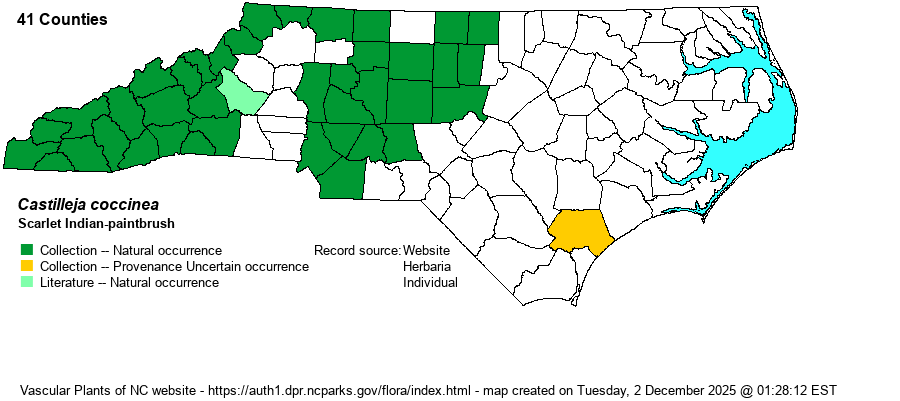| Author | (L.) Sprengel | |
| Distribution | Throughout the Mountains, and nearly all of the Piedmont, but absent in the most eastern and northeastern portion of the latter province; not known east of Person, Orange, Chatham. Montgomery, and Union counties. Collection records for Pender County in the lower Coastal Plain might not represent a natural occurrence.
This is an Eastern species, mostly north and west of NC. Ranges from New England south to northern GA and eastern TX. Several records for coastal SC are possibly not natural. | |
| Abundance | Uncommon to locally common in the Mountains; uncommon in the western Piedmont, where many counties lack specimens. Uncommon to rare in the central Piedmont, but very rare to absent in the far eastern portions. Considered by most field biologists to be declining. | |
| Habitat | This species grows mostly over somewhat high to high pH soils in sunny to partly sunny places, in varying moisture regimes. It occurs in meadows (damp or dry), powerline clearings, grassy roadsides, and wooded borders. | |
| Phenology | Blooms from April to June, and fruits from May to August. | |
| Identification | Though there are numerous species of paintbrushes in the West, the Eastern states have only this one, very familiar to most people except those who limit outdoor activities to the Coastal Plain. It grows usually unbranched, to about 1 foot tall, with alternate leaves; in this family of plants, nearly all others are opposite. The leaves are oddly shaped and very different from nearly all other plants in the state, being trifurcate (3-forked), nearly sessile, with each of the 3 forks being narrowly lanceolate, each about 1-inch long; the base of the leaf is often unforked, and thus the forks (or leaf branches) begin away from the stem. At the top of the stem is a dense spike, with the bract supporting each flower broadly tipped in bright scarlet; each flower is small and greenish-yellow, tubular, generally hidden by each bract. Thus, when in bloom, the familiar "paintbrush" is very obviously bright scarlet at the top, with the reddish color seemingly being the petals as opposed to the bracts. This species seems oddly local, with some meadows containing large numbers, and others none -- perhaps owing to the underlying soil pH. | |
| Taxonomic Comments | None
| |
| Other Common Name(s) | Eastern Indian-paintbrush, Scarlet Painted-cup | |
| State Rank | S3 [S4] | |
| Global Rank | G5 | |
| State Status | | |
| US Status | | |
| USACE-agcp | FAC link |
| USACE-emp | FAC link |

